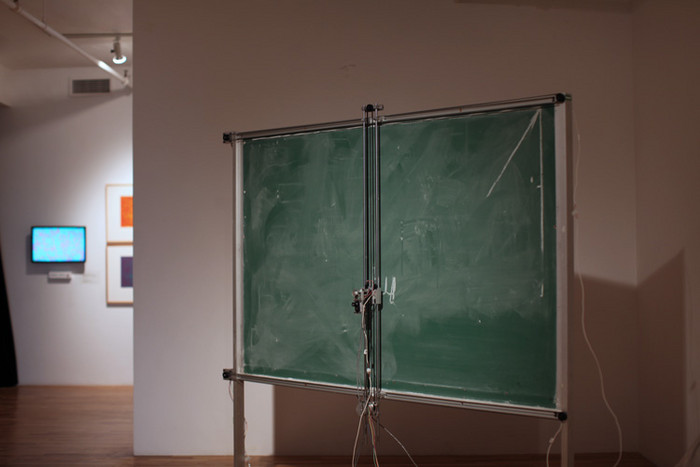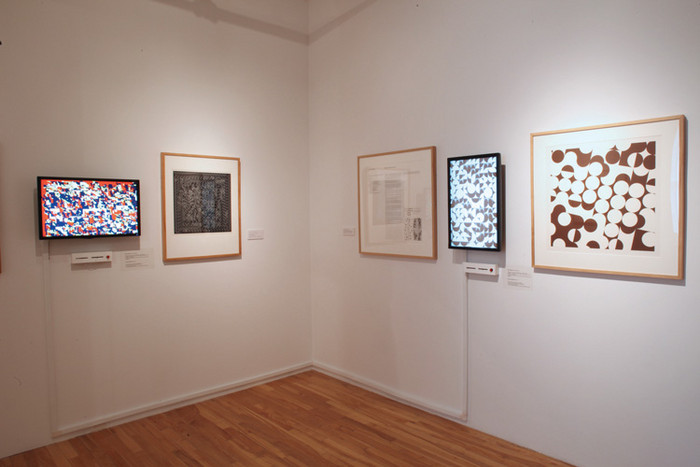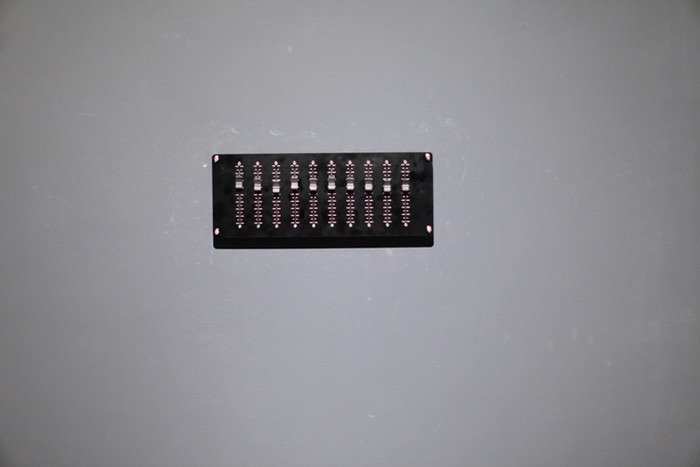Alexandre Castonguay: Inventions
21 Mar - 09 May 2009
Pierre-François Ouellette art contemporain is proud to collaborate with Elektra and to celebrate its 10th anniversary of Elektra with the exhibition "Inventions" of works by Alexandre Castonguay and its collaborators.
In "Inventions", Alexandre Castonguay presents three new pieces—Reversed-Engineering (co-produced with Mathieu Bouchard), Tafel, and EQ—in which he uses subterfuge to reconstruct the forms and discourses that underlie media art. Tafel (chalkboard) consists of a drawing machine that serves as an extreme slow-motion projection device for inscribing program diagrams, artists’ texts, and ordinary email. The works propose playful, interactive situations that are based on programmed re-creations, the replication of artists’ writings, simulated user interfaces, and borrowings from silkscreen works produced in the 1970s. They explore the artist’s relationship with his tools, the disappearance of the unique object, and the emergence of participative processes that entail a de-emphasis of authorship.
On the work entitled Reverse-Engineering co-produced with Mathieu Bouchard, Alexandre Castonguay states: "The computer-generated silkscreen prints I have selected were drawn from the Carlton University Art Gallery’s collection. Produced in 1973 and 1974, these pieces are the work of Manfred Mohr, Miljenko Horvath, Georg Nees, Edward Zajec, Frieder Nake, Ken Knowlton, and Hiroshi Kawano, among others. In each of these artists’ portfolios, the works were accompanied by texts and diagrams with which the artists discuss their intentions and the processes and techniques employed in creating the drawings. In these texts, they also attempt to understand their use of the computer as an instrument for broaching established notions of composition and aesthetics. To varying degrees, these artists have used random processes to free themselves of aesthetic judgment and manual action. Their explanatory texts and diagrams foreground issues of media arts practice that remain surprisingly relevant today, such issues as the relationship between the artist and the machine, the demise of the object, the emergence of a participatory approach that questions the validity of the art market, the loss of authorship, and the integration of technology in our everyday environment. The project aims to reverse engineer these works of the past and thus to actualize the discourse that prevailed at their creation. A computer program by Mathieu Bouchard analyzes the selected images so as to identify the logical principles underpinning their creation in view of generating new ones. This closes the conceptual loop, as the computer is called upon to reevaluate the work of these media arts pioneers. Reverse engineering is an integral part of the process in my recent production and explicitly broaches the history of media arts in order to highlight its forms and discourses."
In "Inventions", Alexandre Castonguay presents three new pieces—Reversed-Engineering (co-produced with Mathieu Bouchard), Tafel, and EQ—in which he uses subterfuge to reconstruct the forms and discourses that underlie media art. Tafel (chalkboard) consists of a drawing machine that serves as an extreme slow-motion projection device for inscribing program diagrams, artists’ texts, and ordinary email. The works propose playful, interactive situations that are based on programmed re-creations, the replication of artists’ writings, simulated user interfaces, and borrowings from silkscreen works produced in the 1970s. They explore the artist’s relationship with his tools, the disappearance of the unique object, and the emergence of participative processes that entail a de-emphasis of authorship.
On the work entitled Reverse-Engineering co-produced with Mathieu Bouchard, Alexandre Castonguay states: "The computer-generated silkscreen prints I have selected were drawn from the Carlton University Art Gallery’s collection. Produced in 1973 and 1974, these pieces are the work of Manfred Mohr, Miljenko Horvath, Georg Nees, Edward Zajec, Frieder Nake, Ken Knowlton, and Hiroshi Kawano, among others. In each of these artists’ portfolios, the works were accompanied by texts and diagrams with which the artists discuss their intentions and the processes and techniques employed in creating the drawings. In these texts, they also attempt to understand their use of the computer as an instrument for broaching established notions of composition and aesthetics. To varying degrees, these artists have used random processes to free themselves of aesthetic judgment and manual action. Their explanatory texts and diagrams foreground issues of media arts practice that remain surprisingly relevant today, such issues as the relationship between the artist and the machine, the demise of the object, the emergence of a participatory approach that questions the validity of the art market, the loss of authorship, and the integration of technology in our everyday environment. The project aims to reverse engineer these works of the past and thus to actualize the discourse that prevailed at their creation. A computer program by Mathieu Bouchard analyzes the selected images so as to identify the logical principles underpinning their creation in view of generating new ones. This closes the conceptual loop, as the computer is called upon to reevaluate the work of these media arts pioneers. Reverse engineering is an integral part of the process in my recent production and explicitly broaches the history of media arts in order to highlight its forms and discourses."




